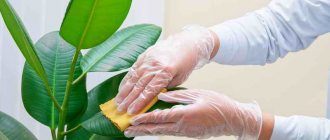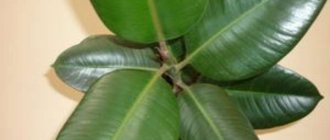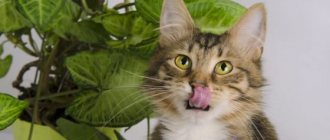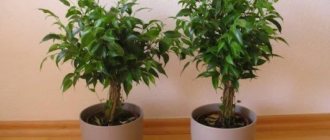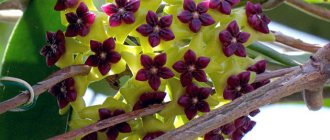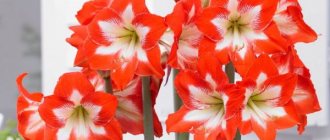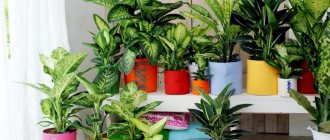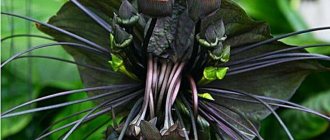floravdome.ru > Aroids > Aglaonema - Growing at home
A beautiful and fairly unpretentious plant, Aglaonema, is perfect for growing in offices and indoor gardening. The main thing is to choose the right variety, since varieties of this spectacular flower may differ slightly in terms of placement and care.
The name Aglaonema translated from Greek sounds like: aglala - shine + nema - thread.
Belongs to the Araceae . Homeland - China and Southeast Asia. It grows on river banks, in tropical forests in the shade of trees. The plant is able to survive and adapt to the most unfavorable conditions.
Aglaonema
Description of Aglaonema
There are more than 50 species and many decorative hybrids that are perfect for indoor growing.
The height of the plant is up to 80 cm. The leaves are large, dense, 10-15 cm long, on long petioles, growing from the trunk, most often of an elongated oval shape, but there are species with narrow long leaves up to 25 cm. The most common leaf color is rich green colors with large spots of a pale silver-green hue.
Varieties have been developed with leaves covered with chaotically located spots of red, orange, pink flowers on a green background, with bright contrasting veins or completely red leaves.
The flowers are yellow-green, the cob, the fruits are red, sometimes light-colored berries, but this plant is still valued for its beautiful variegated leaves.
Aglaonema
Aglaonema is undoubtedly a useful plant. It releases phytoncides that cleanse the air of harmful impurities at home and in office premises, especially in those where synthetic materials and a lot of office equipment predominate.
It has a beneficial effect on the human condition, increasing stress resistance and performance.
Improves the overall energy of the room.
It must be remembered that the plant juice and fruits are poisonous . Broken leaves release poisonous juice, so carry out all procedures for removing leaves or replanting with gloves and wash your hands thoroughly after work.
Place out of the reach of children and animals!!!
Alaonema varieties
Is it possible to keep her in the house?
Despite the fact that aglaonema has long been known as a houseplant, some people are wary of it. The flower would be even more popular if it were not for the belief of many people that it is poisonous.
But aglaonema can, and even should, be kept in the house . The fact is that when it comes to air purification, it is in no way inferior in efficiency to modern filters. Every day, toxic compounds of phenol, benzene and formaldehyde evaporate from plastic or polished surfaces into the air.
Aglaonema leaves absorb these harmful substances like a sponge; in addition, they produce phytoncides, which are fatal to streptococcus.
Aglaonema flowering
From June to August. The flowers are inconspicuous - the spadix is light-colored and covered with a pale green color.
When flowering, the decorative effect of the leaves is partially lost, so it is recommended to remove the flowers.
Aglaonema flower
Seeds
We plant them in a mixture of sand and peat in a greenhouse, watering them regularly. We sow immediately as we harvest. The first shoots appear after 2-3 months. When propagated by seeds, a new plant almost never retains varietal characteristics.
By cuttings
We cut off part of the stem, divide it into parts up to 10 cm, each should have leaves. We treat the sections with charcoal and plant them in a mixture of peat and sand. We create greenhouse conditions and place them in a bright, warm (+25° - +26°) place. Periodically ventilate and moisten. Rooting within 3 weeks.
Side shoots take root well - in water, with the addition of Epin (or another growth stimulant).
Dividing the bush
When transplanting, only mature plants. To prevent root rot, the roots are subsequently washed before dividing, and after dividing, the cut sites are sprinkled with coal.
Signs and superstitions
In its homeland, aglaonema is considered a flower of good luck. This idea began with the story of how a man, in whose garden this flower grew, saw numbers made up of dew drops on its leaves, and used their combination when drawing a lottery. The combination turned out to be a winning one, and the story of the lucky aglaonema began to be passed from mouth to mouth.
You can make friends with this plant not only for the sake of good luck, but also for your own well-being: it improves the health of the air in the room and teaches the owner to discipline. Caring for a houseplant is a responsible task.
Aglaonema transplant
The soil is loose - leaf soil, humus, sand, peat, charcoal (3: 1: 1: 2: a little).
Choose a pot that is wide and shallow. Be sure to add drainage to the bottom up to ¼ of the pot.
The purchased plant is replanted 2-3 weeks after adaptation to new conditions.
Young plants are replanted once a year, adults - no more than once every 3-4 years.
It is better to transplant before the growing season in mid-to-late March.
When replanting, damaged roots are removed.
For bushiness, cut off the top of the stem, treating the cut with charcoal.
Aglaonema grows slowly.
Aglaonema Red
Origin
In order for the plant to feel good in your home and develop normally, you need to create conditions for it that are close to natural. Aglaonema comes from tropical forests native to Southeast Asia. Small bushes of aglaonema take root along the banks of small rivers and lakes, grow along the edges and in the lower tier of humid forests.
In the natural habitat of aglaonema there is high air humidity, heavy rainfall, and loose soil rich in organic matter. Due to its small size, the plant does not receive too much light and is used to growing in moderate light conditions.
Aglaonema pests
Spider mite - the plant is entangled in cobwebs.
♦ The damaged plant is washed, possibly under the shower. Spray the plant with Aktara.
Mealybug - the leaves dry out, pests in the form of small cotton balls are noticeable on different parts of the plant.
♦ Pests are collected. Treat the leaves with a solution of laundry soap and spray with infusion of garlic or wormwood. Treated with insecticides - Actellik, Fitoverm, Fazol.
Aphids - leaves dry out and fall off, pests are visible mainly on the underside of the leaves.
♦ Treat the leaves with a solution of laundry soap and spray with infusion of garlic or wormwood. Treated with insecticides – Actellik, Aktara.
♦ Leaves dry – dry air. Provide moisture around the plant, spray, wipe the leaves.
♦ Leaves turn yellow - too hard or cold water.
♦ Leaves become soft - violation of watering regime - excessive or insufficient. Water the plant when the top layer of soil dries out; if necessary, check for drying at a depth of several centimeters.
♦ Leaves release moisture - excessive watering.
♦ Leaves turn green and lose their decorative colors - lack of lighting.
♦ Spots appear on the leaves - sunburn is possible. The plant should never be placed in direct sunlight.
♦ Leaves lose their decorative appearance and become smaller – lack of nutrients.
♦ Leaves curl and lose their decorative properties - cold air.
Aglaonema
The variety of colors of aglaonema is amazing.
There are varieties with pure green leaves, patterns of all shades of green, colored veins of bright contrasting colors, dark green colors interspersed with pink, red, yellow, orange, and also varieties with red leaves.
The photo shows only some varieties of aglaonema to show the diversity of this beautiful plant.
Aglaonema Maria (Aglaonema Maria) - A popular variety with variegated green narrow and long leaves. Compact, unpretentious.
Aglaonema Silver Queen - A common variety. Dark green leaves with a silver-green “spraying” over almost the entire surface of the leaf. Unpretentious. In warm climates it can be grown outdoors, where it grows up to 80 cm.
Aglaonema Silver Bay - Decorative variety with rounded leaves of a rich dark color with a large silver spot in the center of the leaf. Bushes heavily.
Aglaonema commutatum Silver King - Homeland - Philippines. Erect stems, variegated green leaves on long petioles.
Aglaonema Stripes - Grows up to 50 cm. Leaves have a graceful pattern of silver spots between the veins on an emerald green background.
Aglaonema Peacock - Large variegated leaves of green shades on long petioles.
Aglaonema costatum - Native to Malaysia. Short. Leaves up to 20 cm, pointed, dark green in color with light splashes and a pronounced light central vein.
Painted Aglaonema (Aglaonema pictum) - Homeland - Philippines. Up to 50 cm in height. The leaves are dark green, covered with chaotically located spots of bluish color and different shades of green. Requires high humidity.
Aglaonema Treubii - There are streaks of yellow-green shades on the leaves. Not tall. Unpretentious.
Aglaonema rotundum (Aglaonema Rotundum) - Heart-shaped leaves grow from the ground. There are decorative varieties with bright red veins on a dark green background or red leaves. Sensitive to humidity and conditions.
Aglaonema Modestum - Up to 50 cm. Large leaves of a pleasant uniform green color, slightly wavy at the edges. Shade-loving.
Aglaonema Gold Red
Aglaonema Crete - Young leaves are red, turning green as they mature, retaining a red central vein. Demanding on lighting.
Aglaonema Sab Mongkol - Dense leaves of red-green marbled color. Quite unpretentious.
Aglaonema Red Siam
Share link:
Rate the article!
[Total: 1 Average: 5]
Plant care
Watering
Aglaonema is a moisture-loving resident of the tropics. It is especially demanding of moisture in the spring and summer. At this time, it needs to be watered every other day. In this case, the earthen lump must always be moist. However, water stagnation should not be allowed.
In the autumn-winter period, the need for soil moisture is reduced. The top layer of soil should be allowed to dry before the next watering - it is enough to water the plant every 10 days. Watering of aglaonema kept in a cool room should be especially moderate. It is recommended to heat the water.
It is better to use rain or melt water. If this is not possible, stand or boil it.
The general rule for watering in the cold season is: the lower the air temperature, the less frequent the watering. However, the soil should not be allowed to dry out.
Top dressing
Complex fertilizers for ornamental foliage plants are suitable for aglaonema.
During active plant growth (March-August), fertilizing should be done with a two-week break. In this case, the best effect is achieved by alternately changing liquid organic and complex mineral fertilizers containing nitrogen, potassium and phosphorus.
You can also use a mixture of organic and mineral fertilizers. The quantity and concentration of fertilizers applied must comply with the application rules specified by the manufacturer on the packaging. The plant also responds gratefully to foliar feeding.
Important! Spraying with fertilizer solutions is preferable in cloudy weather to avoid burns.
In winter, feeding is stopped.
Flowering period
The aglaonema flower is not decorative enough to purposefully achieve flowering of the plant. However, with proper care (appropriate soil and pot, lighting, watering, fertilizing) inflorescences, as a rule, appear in the summer.
A modest inflorescence of aglaonema: a spadix with a small greenish veil
Important! If decorative foliage is of greater value to you than flowers, then it is better to remove them immediately. Flowering can cause leaf shredding.
Aglaonema blooms most often in August. After the peduncle dries, you need to carefully cut it off at the base if you do not plan to get seeds. Otherwise, expect red or orange berries
Rest period
This period begins regardless of flowering and lasts quite a long time: from September to February. At this time, the plant needs to ensure an air temperature of at least 16 °C; moderate but regular watering without fertilizing, periodic (2-3 times a week) moistening by spraying with warm water.
Possible growing difficulties
Although aglaonema is quite unassuming, it sometimes suffers from inappropriate conditions. How to recognize the language of a plant in which it asks the gardener for help?
Maintenance errors and their elimination - table
| Problems | Causes | Elimination |
| Drying of leaf tips, loss of elasticity | Low air humidity. | Regular spraying (in a shaded place). |
| Curling leaves, brown rims on them | Low air temperature, drafts. | Move the plant away from the window. |
| Whitish spots on leaves | Sunburn. | Place in the shade, let cool, and spray with a spray bottle. |
| Stunting of growth, browning of outer leaves. | Increased hardness and low water temperature. | Before watering, tap water should stand for 24 hours. |
| Drops of water along the edges of the leaf plate |
|
|
| Yellowing of leaves | Abundant watering at low temperatures. | Move the plant to a warmer room and ensure proper watering. |
| Loss of leaf color saturation | Excessive shading or lack of nutrients. | Provide at least 12 hours of daylight and feed with organic fertilizers. |
| Lack of growth of a young plant | The pot is too spacious. | Wait for the root system to grow, after which the above-ground part will begin to grow, or transplant the plant into a smaller pot. |
How to propagate?
When replanting, the easiest way is to divide the bush into several plants, planting each of them in a separate pot. It is necessary to split in such a way that the separated plants remain with the root system.
The longest and most troublesome propagation is by seeds. If your plant decides to make you happy with its flowering, then after a while red berries with seeds will ripen on the cob. Seeds can be planted in the ground and try to germinate. To do this, you will need to cover them with glass to prevent them from drying out, ensure the temperature is not lower than 25°C, and raise the glass twice a day for ventilation. After a few weeks, the seeds may hatch. Then the seedlings need to be planted in small pots and covered with transparent caps until they get stronger.

